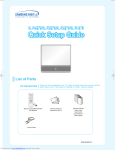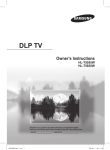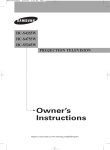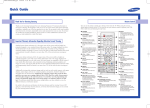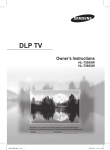Download Samsung 653-068 User's Manual
Transcript
BP68-00426A-00_QG_0831 9/3/04 3:11 PM Page 1 Quick Guide Connections Connecting VHF and UHF Antennas Connecting a Camcorder Connecting a DVD Player If you do not have a cable system, you will need to connect an antenna to your TV. The side panel jacks on your TV make it easy to connect a camcorder to your TV. You can use your camcorder to view tapes without using a VCR. The rear panel jacks on your TV make it easy to connect a DVD player to your TV. Antennas with 300-ohm Flat Twin Leads If your antenna looks like this: it has 300-ohm flat twin leads. If your antenna looks like this: Locate the A/V output jacks on the camcorder. They are usually found on the side or back of the camcorder. Camcorder Antennas with 75-ohm Round Leads it is an antenna with 75-ohm round leads. TV Side Panel Camcorder Output Jacks Connect a set of audio cables between the AUDIO IN jacks on the TV and the AUDIO OUT jacks on the camcorder. If you have mono camcorder, connect L(mono) to camcorder audio out using only one audio cable. Connect a video cable between the VIDEO IN (or S-VIDEO IN) jack on the TV and the VIDEO OUT jack on the camcorder. The audio-video cables shown here are usually included with a Camcorder. (If not, check your local electronics store.) If your camcorder is stereo, you need to connect a set of two cables. Connecting to Y, PB, PR Connecting to audio and video jacks Connect a set of audio cables between the COMPONENT (1 or 2) audio (L, R) in jacks on the TV and the AUDIO OUT jacks on the DVD player. To enable Component video viewing, connect a set of video cables between the COMPONENT (1 or 2) VIDEO (Y, PB, PR) in jacks on the TV and VIDEO (Y, PB, PR (or Y, CB, CR) OUT jacks on the DVD player. Connect a set of audio cables between the Audio in (1 or 2) jacks on the TV and the AUDIO OUT jacks on the DVD player. Connect a video cable between the VIDEO IN (1 or 2) jack on the TV and the VIDEO OUT jack on the DVD player. TV Rear Panel Place the wires from the twin leads under the screws on the 300-75 ohm adaptor (not supplied). Use a screwdriver to tighten the screws. Plug the adapter into the “ANT 1 IN” terminal on the rear panel. TV Rear Panel Plug the antenna lead into the “ANT 1 IN” terminal on the rear panel. Connecting a DTV Set-Top Box Separate VHF and UHF Antennas If you have two separate antennas for your TV (one VHF and one UHF), you must combine the two antenna signals before connecting the antennas to the TV. This procedure requires an optional combiner-adaptor (available at most electronics shops). Connecting to Y, PB, PR Connecting to DVI (Digital Visual Interface) Connect a set of audio cables between the COMPONENT (1 or 2) audio (L, R) in jacks on the TV and the AUDIO OUT jacks on the Set-Top Box. Connect a set of video cables between the COMPONENT (1 or 2) VIDEO (Y, PB, PR) in jacks on the TV and VIDEO (Y/PB/PR or Y/CB/CR) OUT jacks on the Set-Top Box. Connect a set of audio cables between the DVI audio (L, R) in jacks on the TV and the AUDIO OUT jacks on the Set-Top Box. Connect a video cable between the DVI IN jack on the TV and the DVI OUT jack on the Set-Top Box. Connect both antenna leads to the combiner. Plug the combiner into the “ANT 1 IN” terminal on the rear panel. Incoming Cable or Antenna Incoming Cable or Antenna TV Rear Panel DVD Player DVD Player NOTE : For an explanation of Component video, see your DVD player's owner's manual. Incoming Cable or Antenna Connecting Cable TV and VCR You can connect different cable systems to your TV, including cable without a cable box, and cable with a cable box that descrambles some or all channels. TV Rear Panel From Cable This connection allows you to watch cable and premium channels. You should keep your TV selected to “ANT 1 IN” so that you can use the TV features. When viewing premium channels, select “ANT 2 IN” and tune the TV to channel 3 or 4 (whichever channel is vacant in your area), then use the converter box to change channels. You will need two coaxial cables. NOTES • When you use a converter box with your TV, there may be features that you can not program using the remote control, such as programming your favorite channels and blocking channels. • The output from “ANT 1 OUT” is available when select “Ant.2” in the “Antenna“ channel menu. TV Rear Panel From Cable Connecting a Cable Converter Box and a VCR PC Display Incoming Cable or Antenna Connecting a Cable Converter Box TV Rear Panel DTV Set-Top Box DTV Set-Top Box NOTE : For an explanation of Component video, see your Set Top Box owner's manual. How to Connect Your PC to the TV Connecting to R,G,B Connecting to HDMI (High Definition Multimedia Interface) Connect a set of audio cables between the PC audio (L, R) in jacks on the TV and the AUDIO OUT jacks on the Set-Top Box. Connect a video cable between the PC IN jack on the TV and the R.G.B OUT jack on the Set-Top Box. Connect a HDMI cable between the HDMI IN jack on the TV and the HDMI OUT jack on the Set-Top Box. TV Rear Panel Using Your TV as a Computer (PC) Display This figure shows the Standard Connector-jack panel. The actual configuration on your TV may be different, depending on the model. TV Rear Panel TV Rear Panel This connection allows you to watch and record basic and premium cable channels, as well as watch videotapes. You should keep your TV selected to “ANT 1 IN” so that you can use the TV’s features. When viewing premium channels or recording with the VCR, select “ANT 2 IN” (whichever channel is vacant in your area), then use the converter box to change channels. 15Pin(D-Sub) Cable Audio Cable Caution: If you want to record one channel while watching another channel, a splitter (not included) must be added between the cable and “ANT 1 IN”. One output of the splitter goes to “ANT 1 OUT” and the second output is connected to IN on the cable converter box. If you have a mono VCR, connect L/Mono to VCR Audio OUT using only one audio cable. If you have a S-VHS VCR, use the S-video connections and remove the video cable. Do not connect the video cable and the S-video cable to video1 simultaneously. VCR When you use a converter box with your TV there may be features that you can not program using the remote control, such as programming your favorite channels and blocking channels. Incoming Cable or Antenna Incoming Cable or Antenna DTV Set-Top Box PC DTV Set-Top Box NOTE : Please check if the power of HDMI source is on, in case that you fail to select HDMI from the “Source List” even after you connected the cable of HDMI source (DTV Set-Top Box, DVD, etc.) to TV. NOTE : The “Anynet” jack is for repairs and software upgrades. BP68-00426A-00_QG_0831 9/3/04 3:11 PM Page 2 Quick Guide Operation Front Panel LED Indicators Selecting the Video Signal Source Storing Channels in Memory (Automatic Method) Before your TV can begin memorizing the available channels, you must specify the type of signal source that is connected to the TV (i.e., an antenna or a cable system). First, select the correct signal source (“Air”, “STD”, “HRC” or “IRC”) as described before. Press the MENU button. Press the … or † button to select “Channel”, then press the ENTER button. Channel Input Picture Sound Channel Press the … or † button to select “Air/CATV”, then press the ENTER button. Setup Move Enter √ √ √ √ √ √ √ Return Channel Input If you are connected to an antenna, press the … or † button to select “Air”. If you connected cable, press the … or † button to select the type of cable system: “STD”, “HRC” or “IRC”. Antenna : Ant.1 Air/CATV : Air Auto Program Add/Delete Favorite Channels Name Fine Tune ▼ More Picture Sound Channel Setup Antenna : Air Ant.1 Air/CATV : STD Air Auto Program HRC Add/Delete IRC Favorite Channels Name Fine Tune ▼ More Move Enter Return Press the MENU button. Press the … or † button to select “Channel”, then press the ENTER button. Remote Control The three lights on the front panel indicate the status of your TV. You can use the remote control up to about 23 feet from the TV. When using the remote control, always point it directly at the TV. You can also use your remote control to operate your Set-Top Box, VCR, Cable box or DVD player. Channel Input Picture Sound Channel Press the … or † button to select “Auto Program”, then press the ENTER button. Your New Wide TV Setup Press the ENTER button to start the auto program. The TV begins memorizing all of the available stations. Press the ENTER button at any time to interrupt the memorization process. Press the EXIT button to exit. Move 1. POWER Turns the TV on and off. √ √ √ √ √ √ √ Antenna : Ant.1 Air/CATV : Air Auto Program Add/Delete Favorite Channels Name Fine Tune ▼ More 2. S.MODE Adjust the TV sound by selecting one of the preset factory settings. (or select your personal, customized sound settings.) Return Enter Auto Program 3. P.MODE Adjust the TV picture by selecting one of the preset factory settings. (or select your personal, customized picture settings.) Start Enter Return Auto Program Air 11 4. +100 Press to select cable channels over 100 on TV. Stop Enter Return Press the EXIT button to exit. 5. VOL +, VOL Press to increase or decrease the volume. 6. MUTE Press to mute the TV sound. 7. Anynet Runs the Anynet view functions and sets up the Anynet devices. Special Features 8. MENU Displays the main on-screen menu. Customizing Your Remote Control Your TV comes equipped with a universal remote control. In addition to controlling the TV, the universal remote control can also operate a VCR, Cable box, DVD and Set-Top Box made by Samsung (even if your VCR, Cable box and DVD are made by manufacturers other than Samsung). NOTE : The remote control might not be compatible with all VCRs, DVD players and Cable boxes. 9. STILL Press to stop the action during a particular scene. Press again to resume normal video. Indicator Light Key : Light is On : Light is Blinking : Light is Off 10. P.SIZE Press to change the picture size. Setting Up Your Remote Control to Operate Your VCR (Cable box or DVD player) Turn off your VCR (Cable box or DVD player). Press the MODE button to switch the remote control to the VCR (CABLE or DVD) mode. The remote control has five modes: TV, STB, VCR, CABLE and DVD. On your Samsung remote control, press the SET button. Enter 3 digits of the VCR (Cable box or DVD player) code listed on next page for your brand of VCR (Cable box or DVD player). Make sure you enter 3 digits of the code, even if the first digit is a “0”. (If more than one code listed, try the first one.) Press the POWER button. Your VCR (Cable box or DVD player) should turn on. If your VCR (Cable box or DVD player) turns on, your remote control is now set correctly. If your VCR (Cable box or DVD player) does not turn on, repeat steps 2, 3, and 4, but try one of the other codes listed for the brand of your particular VCR (Cable box or DVD player). Once your remote control is set up, press the MODE button any time you want to use the remote to operate your VCR (Cable box or DVD player). NOTES • When your remote is in the TV mode, the VCR (or DVD player) control buttons (REW, STOP, PLAY/PAUSE and FF) will still operate your VCR (or DVD player). • When your remote control is in the STB, VCR, CABLE or DVD mode, the volume buttons still control your TV’s volume. TIMER LAMP STAND BY/TEMP 11. MODE Selects a target device to be controlled by the Samsung remote control (i.e., TV, STB, VCR, CABLE, or DVD). Indication Standby state. 12. PRE-CH Tunes to the previous channel. The picture will automatically appear in about 15 seconds. Auto Timer ON/OFF has been set and the set will automatically be turned on in about 25 seconds. Lamp cover on rear of the set is not properly shut. 13. SOURCE Press to display all of the available video sources (i.e., TV, Set-Top Box, VCR, DVD, DTV, PC). Check if the ventilation hole on the rear of the set is blocked, because if the inner temperature is too high, the power will shut off. 14. CH , CH Press to change channels. A cooling fan inside the set is not operating normally. 15. INFO Press to display information on the TV screen. Lamp may be defective. Please contact a certified technician. • It takes about 30 seconds for the TV to warm up, so normal brightness may not appear immediately. 16. EXIT Press to exit the menu. • The TV has a fan to keep the inside lamp from overheating. You’ll occasionally hear it working. 17. …, †, œ, √, ENTER Press to select highlight up, down, left, or right. While using the on-screen menus, press the ENTER to activate (or change) a particular item. BP68-00426A-00 18. MTS (MULTICHANNEL TELEVISION STEREO) Press to choose Stereo, Mono or SAP (Secondary Audio Program). 19. SRS Activates TruSurround. 20. ADD/DEL Press to add or erase channels in the TV’s memory. Use the ADD/DEL button to memorize and erase the fine tuning after fine tuning channels. 21. SLEEP Press to select a preset time interval for automatic shutoff. 22. PIP (Picture In Picture) Activates PIP. 23. Fav.CH (Favorite Channel) Press to switch between your favorite channels. 24. SET Used during set up of this remote control, so that it will work compatibly with other devices (Set-Top Box, VCR, Cable box, DVD, etc.). 25. DNIe (Digital Natural Image engine) Activates DNIe. 26. PIP Controls SWAP; Press to exchange the video signal that is currently displayed on the main screen with the signal in the PIP window. CH / ; Press to display the available channels in sequence. (These buttons change channels in the PIP window only.) 27. VCR/DVD Controls Controls VCR or DVD functions: Rewind, Stop, Play/Pause, Fast Forward. 28. RESET If your remote control is not functioning properly, take out the batteries and press the reset button for about 2~3 seconds. Re-insert the batteries and try using the remote control again.





